I feel obliged to say that the next few posts on my blog will be about the New Year in Japan. None of them will really have interesting observations that haven’t been made before, many times, by foreigners in Japan. That is one kind of interesting thing about being a foreigner in Japan: you go through phases. I’ll have to write about that at some time, but we all go through a “I’m a funny guy and will comment on these crazy Japanese” as well as a “wow, look at all the cool cultural things they have here” phase. You can probably find any number of similar posts on the blogs listed at the Japan Blog List.
I have been in Japan for about one year and nine months now. Last year, I spent the new year on my own, and visited a local temple. I didn’t know what was going on really, but I enjoyed it. This year, I had the chance to spend New Year’s Eve with a Japanese family. I was looking forward to the chance, because the New Year’s holiday is one of the biggest holidays in Japan, very similar to a mix of Christmas and Thanksgiving in the United States, where families gather together and eat food while celebrating the New Year and reflecting on the year gone past. (Although in practice it reduces down to over-eating and watching people sing on TV. I’ll write more about that in a later post.)
The main thing to which I was looking forward was Osechi Food (おせち料理), which is the kinds of food that families each over the New Year’s Holiday. I never really had a good idea about the food consisted of, and now after having experienced it, I’m pretty sure that there are not any real set dishes aside from a few common things, and that anything can be Osechi Food. It is just a time for the family to gather, sit around the table, eat, and enjoy.
On New Year’s Eve it is traditional to eat a special kind of Soba called Toshikoshi Soba. I didn’t know the origins of this custom, and found two interesting sties with more information on it. One is at jpn-miyabi.com and the other is at urban.ne.jp. It seems like soba (buckwheat noodles) are traditionally thought to symbolize long life and good fortune. The custom dates back to the Edo period, perhaps around 1700 or so, perhaps earlier. More interesting is this post over on justhungry.com where they have a nice recipe for Toshikoshi Soba. The Soba that we had was nice, although grandma humbly complained that it has weak flavor, and tasty. It had some great wild mushrooms in there, and some chicken. I hope it passed on to me the attributes of long life and wealth, but I’m afraid all it did for me was to fill me up before the main course: Sukiyaki.
Sukiyaki is a food that it seems like is a traditional Japanese “comfort food”. Lots of people associate it with happy times with the family, sitting around the table and talking happily. I have had Sukiyaki a few times, and I think it is really great. Absolutely delicious. I was told that the Kansai (Kyoto / Osaka area) version of Sukiyaki uses a sweet sugar base with Mirin, while the Tokyo version uses a salt-based sauce. This version was the sugar-based one, and I thought it was great. What happens is you put food – vegetables, meat, and so on – into the Sukiyaki bowl, and pull it out as it cooks. If you like, you can take a raw egg and crack it open into a bowl, which you then dip things into. I am not crazy about the raw-egg-on-things custom that the Japanese harbor, but I don’t dislike it. (Other places where you can find this include Yoshinoya, where you can get a raw egg to put on your beef bowl, and many of the “o-don” dishes where the raw egg cooks, essentially, over the hot rice.) Incidentally, you can buy eggs at the supermarket that are specifically meant to be eaten raw for this kind of purpose. I suppose they have some sort of higher quality standard for safety or whatever, but I’m not really sure.
Along with the Sukiyaki meal there were other small dishes, such as mochi (rice cake) both cold and hot with soy sauce on it, and of course alcohol. The New Year’s Eve meal was accompanied by sake and beer. And not a small amount: every time I checked, my cup had been re-filled. I also made sure to do my duty and keep the cups of those around me full. After dinner, we all gathered around the TV to watch the special sets of shows that are specific to New Year’s Eve, and pass the time until midnight. I won’t go into detail about that here, but shortly after midnight we went to bed. I slept on a Japanese futon, the first time in quite a while, and woke up with a sore back.
The next morning at 9:00am we gathered for breakfast, which is the proper Osechi Food. There were two main components to the meal: the Ocean Foods, and the Mountain Foods. The Ocean foods consisted of things from the Ocean and peculiarly a sweetened mashed-like Potato dish that I really enjoyed. I liked the Ocean Foods a lot because they are colorful and made a very pretty arrangement on the plate. The traditional colors of the New Year are Red and White, and some delicious seafood cakes took on those colors. Sadly, I don’t know what everything on the plate is, but it was all quite nice. The Mountain Foods are fresh vegetables and things like that, including mushrooms and other things that I don’t know. As with many of the foods, some were round and in a ball-form since that symbolizes good luck. There are some beans that are traditional as well, but I don’t know the story behind that. Interestingly, you can see in the lower-left of the photo that I took that there is a bottle of Sake and three bowls for drinking, each smaller and with a good-luck character written on them. Before breakfast everyone at the table had a saucer of the sake before the saucers ended up with their rightful owners (in this case, the head of the household, his daughter, and myself.) I enjoyed having sake for breakfast, although it isn’t something that I want to do every day. The final part of the meal was the Mochi (rice cake) soup. I’m not sure what all was in it, but it was quite nice. As with the previous night’s dinner, mochi (rice cakes) were present and I was given a rice cake roasted with soy sauce and then wrapped up in nori (seaweed.) It was nice, but those rice cakes can fill you up really fast. They are heavy, sticky, and sink to you stomach. I’m pretty sure I added a layer of fat composed entirely of rice cake over this three day period.
After breakfast Lisa and I headed out for our first temple visits of the year, which I’ll document in a later post. We returned after a few hours, and snacked on tea and some cakes, before dinner at 6:30pm. I didn’t get any pictures of the tea that we had, but I had a very, very large amount of tea over those three days.
Dinner was Western Style (on my account?) consisting of Roast Beef that Lisa and her grandmother cooked previously, some salad, and leftovers from the previous day’s food. Of course, the Sake tradition continued, but this time we also had two bottles of Red Wine to go with the meat. The roast beef was quite nice, but curiously served cold. Actually, that isn’t all that surprising; Japanese often eat meals (Bento boxes in particular) which are cold, and I’ve had roast before here before that was served cold. It was still quite nice. To accompany the beef there were two sorts of sauces: one was standard Wasabi like you would get with Sushi, and the other was a type of salt, called “Yuzu Salt”, that was very nice. Yuzu is a Japanese Citrus, and this salt was made with Yuzu in some way. I’ve equated it with Garlic Salt in my mind, and will try to pick some up next time I’m at a shop that might have some.
After dinner, I went back home so that I could sleep in my own bed, but I was asked to come back for breakfast the next morning at 9:30am. Breakfast consisted of the same foods seen previously, and more Breakfast Sake. To tell the truth, I was still absolutely stuffed from all the food over the past two days, but I think the point of the New Year Holiday is to save up energy and fat for the coming busy times when everyone goes back to work and does their standard twelve hours days subsisting on only ramen. After breakfast the family watched some more TV, then Lisa and I went out to hit the last two temples on our temple card. More on the Temple Visits and crazy Japanese New Year’s TV at a later date.




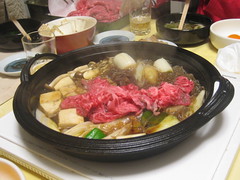
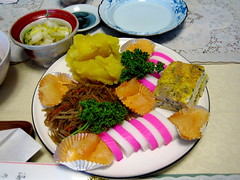
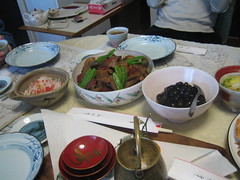
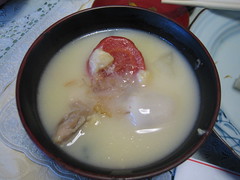
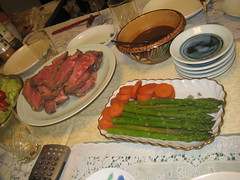
Leave a Reply